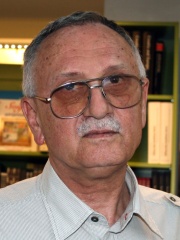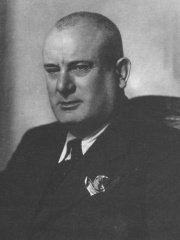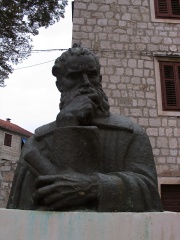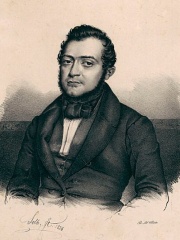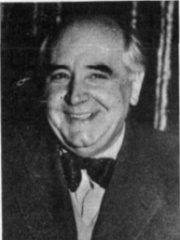
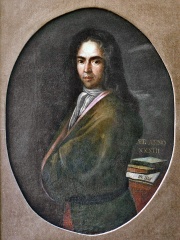
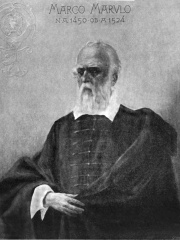
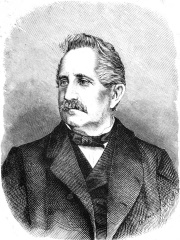
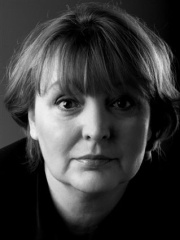
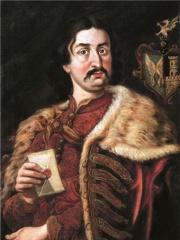
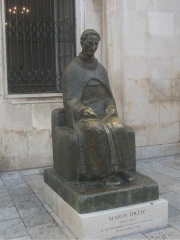
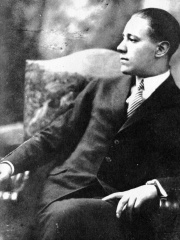
The Most Famous
WRITERS from Croatia
Top 10
The following people are considered by Pantheon to be the top 10 most legendary Croatian Writers of all time. This list of famous Croatian Writers is sorted by HPI (Historical Popularity Index), a metric that aggregates information on a biography’s online popularity. Visit the rankings page to view the entire list of Croatian Writers.

1. Miroslav Krleža (1893 - 1981)
With an HPI of 61.61, Miroslav Krleža is the most famous Croatian Writer. His biography has been translated into 35 different languages on wikipedia.
Miroslav Krleža (pronounced [mǐrɔ̝slav̞ kř̩le̞ʒa]; 7 July 1893 – 29 December 1981) was a Yugoslav and Croatian writer who is widely considered to be the greatest Croatian writer of the 20th century. He wrote notable works in all the literary genres, including poetry (Ballads of Petrica Kerempuh, 1936), theater (Messrs. Glembay, 1929), short stories (Croatian God Mars, 1922), novels (The Return of Philip Latinowicz, 1932; On the Edge of Reason, 1938), and an intimate diary. His works often include themes of bourgeois hypocrisy and conformism in Austria-Hungary and the Kingdom of Yugoslavia. Krleža wrote numerous essays on problems of art, history, politics, literature, philosophy, and military strategy, and was known as one of the great polemicists of the century. His style combines visionary poetic language and sarcasm. Krleža dominated the cultural life of Croatia and Yugoslavia for half a century. A "Communist of his own making", he was criticized in Communist circles in the 1930s for his refusal to submit to the tenets of socialist realism. After the Second World War, he held various cultural posts in Socialist Yugoslavia, and was most notably the editor of the Yugoslav Lexicographical Institute and a constant advisor on cultural affairs to President Tito. After the break with Stalin, it was his speech at the 1952 Congress of Yugoslav Writers that signaled a new era of comparative freedom in Yugoslav literature.

2. Ivan Gundulić (1589 - 1638)
With an HPI of 61.54, Ivan Gundulić is the 2nd most famous Croatian Writer. His biography has been translated into 29 different languages.
Dživo Franov Gundulić (Italian: Gianfrancesco Gondola; 8 January 1589 – 8 December 1638), better known today as Ivan Gundulić, was the most prominent Baroque poet from the Republic of Ragusa (now in Croatia). He is regarded as the Croatian national poet. His work embodies central characteristics of Roman Catholic Counter-Reformation: religious fervor, insistence on "vanity of this world" and zeal in opposition to "infidels". Gundulić's major works—the epic poem Osman, the pastoral play Dubravka, and the religious poem Tears of the Prodigal Son (based on the Parable of the Prodigal Son) are examples of Baroque stylistic richness and, frequently, rhetorical excess.

3. Marko Marulić (1450 - 1524)
With an HPI of 61.42, Marko Marulić is the 3rd most famous Croatian Writer. His biography has been translated into 29 different languages.
Marko Marulić Splićanin (Croatian pronunciation: [mâːrko mǎrulitɕ splîtɕanin]; in Latin Marcus Marulus Spalatensis; 18 August 1450 – 5 January 1524), was a Croatian poet, lawyer, judge, and Renaissance humanist who coined the term "psychology". He is the national poet of Croatia. According to George J. Gutsche, Marulic's epic poem Judita "is the first long poem in Croatian", and "gives Marulić a position in his own literature comparable to Dante in Italian literature." Furthermore, Marulić's Latin poetry is of such high quality that his contemporaries dubbed him "The Christian Virgil." Marulić has been called the "crown of the Croatian medieval age", the "father of the Croatian Renaissance", and "The Father of Croatian literature." According to Marulić scholar Bratislav Lučin, he was well-versed in both the Christian Bible and in the Fathers of the Church. At the same time, Marulić also attentively read the Pre-Christian Greek and Latin classics. He read and interpreted Latin epigrams, wrote glosses on the erotic poetry of Catullus, read Petronius' Satyricon, and admired Erasmus of Rotterdam. Marulić also composed epic works of Christian poetry, humanist elegies, and even satirical and erotic epigrams. According to Franz Posset, Marulić aspired to the Renaissance humanist ideal of the uomo universale ("universal man"). To this end, he was interested in painting and drawing, local and national history, languages, and poetry. His overall goal always remained renovatio Christiana ("The Renewal of Christianity") as represented by the future Counter-Reformation. This is why, like many other Renaissance humanists who shared his views, Marulić denounced simony and immorality among Roman Catholic priests and members of the Hierarchy in often violent language throughout his writings. However, even though Marulić and Martin Luther lived at the same time and were published by two of the same Basel printers, their collected writings make no mention of each other. Lacking new discoveries, it must be assumed that both theologians were simply unaware of the other's existence. At the same time, both men shared a common belief in Evangelica Veritas ("Gospel Truth") and "theology for piety". They also both built their differing theology upon the similar training they both received in scholasticism, Renaissance humanism, and Devotio moderna. Like fellow Renaissance humanists Johann Reuchlin, Erasmus of Rotterdam, Thomas More, and John Fisher, however, Marko Marulić remained committed to an internal renewal of Roman Catholicism and loyal to the Holy See, while Martin Luther and his adherents did not. At the same time, though, Marulić's writings were admired both by many of the greatest and most influential Catholic saints of the Counter-Reformation and also, as much of Marulić could be read without violating Sola Scriptura, by generations of believers in Protestantism. Marulić's writings in Renaissance Latin, once adored and envied across Europe, shared the destiny that befell most Renaissance Humanist literature and faded into obscurity. According to Lučin, however, the passage of time has slowly revealed the important web of influence that the poet and writer wove all over Europe and far beyond its borders. Marulić's writings were admired by churchmen such as Saints Francis Xavier, Francis de Sales, Peter Canisius, and Charles Borromeo, by monarchs and statesmen such as King Henry VIII, Thomas More, and Emperor Carl V, and emulated by poets like Jan Dantyszek, Conrad Peutinger, and Francisco de Quevedo. Furthermore, manuscripts of Marulić works previously thought to have been lost, such as his Christian epic poem the Davidiad in 1952, his Latin-Croatian literary translation of Thomas à Kempis' The Imitation of Christ in 1989, and the Glasgow Codex in 1995, continue to resurface and to belatedly see publication for the first time. More recently, Pope John Paul II quoted from a Marulić poem during his 1998 Apostolic Visit to Solin, Croatia.

4. Ljudevit Gaj (1809 - 1872)
With an HPI of 59.21, Ljudevit Gaj is the 4th most famous Croatian Writer. His biography has been translated into 29 different languages.
Ljudevit Gaj (Croatian: [ʎûdeʋit ɡâːj]; born Ludwig Gay; Hungarian: Gáj Lajos; 8 August 1809 – 20 April 1872) was a Croatian linguist, politician, journalist and writer. He was one of the central figures of the pan-Slavist Illyrian movement.
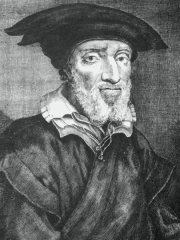
5. Matthias Flacius (1520 - 1575)
With an HPI of 58.94, Matthias Flacius is the 5th most famous Croatian Writer. His biography has been translated into 26 different languages.
Matthias Flacius Illyricus (Latin; Croatian: Matija Vlačić Ilirik) or Francovich (Croatian: Franković) (3 March 1520 – 11 March 1575) was a Lutheran reformer from Istria, present-day Croatia. He was notable as a theologian, sometimes dissenting strongly with his fellow Lutherans, and as a scholar for his editorial work on the Magdeburg Centuries.

6. Dubravka Ugrešić (1949 - 2023)
With an HPI of 56.90, Dubravka Ugrešić is the 6th most famous Croatian Writer. Her biography has been translated into 33 different languages.
Dubravka Ugrešić (Croatian pronunciation: [dûbraːʋka ûgreʃit͡ɕ]; 27 March 1949 – 17 March 2023) was a Yugoslav-Croatian and Dutch writer. A graduate of University of Zagreb, she was based in Amsterdam from 1996 and continued to identify as a Yugoslav writer.

7. Petar Zrinski (1621 - 1671)
With an HPI of 56.72, Petar Zrinski is the 7th most famous Croatian Writer. His biography has been translated into 16 different languages.
Petar IV Zrinski (Hungarian: Zrínyi Péter) (6 June 1621 – 30 April 1671) was Ban of Croatia (Viceroy) from 1665 to 1670, general and a writer. A member of the Zrinski noble family, he was noted for his role in the attempted Croatian-Hungarian Magnate conspiracy to overthrow the Habsburgs, which ultimately led to his execution for high treason.

8. Marin Držić (1508 - 1567)
With an HPI of 56.59, Marin Držić is the 8th most famous Croatian Writer. His biography has been translated into 17 different languages.
Marin Držić (Croatian pronunciation: [mâriːn dř̩ːʒitɕ]; also Marino Darza or Marino Darsa; 1508 – 2 May 1567) was a Croatian writer from Republic of Ragusa. He is considered to be one of the finest Renaissance playwrights and prose writers of Croatian literature.

9. Ödön von Horváth (1901 - 1938)
With an HPI of 56.52, Ödön von Horváth is the 9th most famous Croatian Writer. His biography has been translated into 35 different languages.
Edmund Josef von Horváth (9 December 1901, in Sušak, Rijeka, Austria-Hungary – 1 June 1938, in Paris, French Third Republic) was an Austro-Hungarian playwright and novelist who wrote in German, and went by the nom de plume Ödön von Horváth. He was one of the most critically admired writers of his generation prior to his untimely death. He enjoyed a series of successes on the stage with socially poignant and romantic plays, including Revolte auf Côte 3018 (1927), Sladek (1929), Italienische Nacht (1930), Hin und Her (1934), and Der Jüngste Tag (1937). His novels include Der ewige Spießer (1930), Ein Kind unserer Zeit (1938), and Jugend ohne Gott (1938).
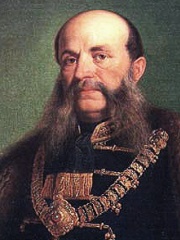
10. Ivan Mažuranić (1814 - 1890)
With an HPI of 55.22, Ivan Mažuranić is the 10th most famous Croatian Writer. His biography has been translated into 22 different languages.
Ivan Mažuranić (pronounced [ǐʋan maʒǔranitɕ]; 11 August 1814 – 4 August 1890) was a Croatian poet, linguist, lawyer and politician who is considered to be one of the most important figures in Croatia's political and cultural life in the mid-19th century. Mažuranić served as Ban of Kingdom of Croatia-Slavonia between 1873 and 1880, and since he was the first ban not to hail from old nobility, he was known as Ban pučanin (Ban commoner). His realistic assessment of strengths and weaknesses of Croatia's position between Austrian bureaucracy and Hungarian expansionist nationalism proved invaluable to his home country during the wider political turmoil in mid and late 19th century Europe. Mažuranić is best remembered for his contributions to the development of the Croatian law system, economics, linguistics, and poetry.
Pantheon has 33 people classified as writers born between 1450 and 1961. Of these 33, 3 (9.09%) of them are still alive today. The most famous living writers include Slavenka Drakulić, Pavao Pavličić, and Miro Gavran. The most famous deceased writers include Miroslav Krleža, Ivan Gundulić, and Marko Marulić. As of April 2022, 3 new writers have been added to Pantheon including Petar Hektorović, Dimitrija Demeter, and Frano Selak.
Living Writers
Go to all Rankings
Slavenka Drakulić
1949 - Present
HPI: 53.66
Pavao Pavličić
1946 - Present
HPI: 42.64
Miro Gavran
1961 - Present
HPI: 36.45

Deceased Writers
Go to all Rankings
Miroslav Krleža
1893 - 1981
HPI: 61.61
Ivan Gundulić
1589 - 1638
HPI: 61.54
Marko Marulić
1450 - 1524
HPI: 61.42
Ljudevit Gaj
1809 - 1872
HPI: 59.21
Matthias Flacius
1520 - 1575
HPI: 58.94
Dubravka Ugrešić
1949 - 2023
HPI: 56.90
Petar Zrinski
1621 - 1671
HPI: 56.72
Marin Držić
1508 - 1567
HPI: 56.59
Ödön von Horváth
1901 - 1938
HPI: 56.52
Ivan Mažuranić
1814 - 1890
HPI: 55.22
Tin Ujević
1891 - 1955
HPI: 55.17
Petar Hektorović
1487 - 1572
HPI: 53.05

Newly Added Writers (2022)
Go to all Rankings
Petar Hektorović
1487 - 1572
HPI: 53.05
Dimitrija Demeter
1811 - 1872
HPI: 47.56
Frano Selak
1929 - 2016
HPI: 45.55

Which Writers were alive at the same time? This visualization shows the lifespans of the 21 most globally memorable Writers since 1700.


